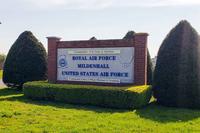CAMP COURTNEY, OKINAWA, Japan — It’s a scene that has played out in real life and on Hollywood’s silver screen countless times. Service members are deployed to a country, tasked with distributing food, water and other emergency supplies to victims of a disaster. The people are hungry, thirsty, tired and perhaps have lost their homes. In this distressing state, they panic over the thought there won’t be any for them, or there won’t be enough to support their family. The panic spreads, and the crowd becomes a mob, and the mob becomes a riot.
Marines with Golf Battery, Battalion Landing Team 1st Battalion, 5th Marines, 31st Marine Expeditionary Unit experienced this same scenario while training to conduct humanitarian assistance and disaster relief missions as part of Marine Expeditionary Unit Exercise 16-1, Dec. 15, on Camp Courtney in Okinawa, Japan.
The mission was one of many the Marines and sailors of the 31st MEU had to complete as part of MEUEX, an exercise designed to prepare the MEU for its upcoming deployment.
“It’s a key mission for the 31st MEU because of the instability and poverty in U.S. Pacific Command area of responsibility,” explained Capt. Albert Bellamy, a Wadsworth, Ohio, native, and the commanding officer of Golf Battery, BLT 1/5, 31st MEU. “With the weather patterns, there tends to be natural disasters in this region and they tend to affect the native populations severely,”
Golf Battery, the MEU’s artillery unit, was given the humanitarian assistance and disaster relief mission with only a short window of time to plan and carry it out, but was ready nonetheless.
“Any unit with the 31st MEU can be tasked with (a HADR mission),” said Bellamy. “And so we have the necessary number of Marines, we have the command structure and we have the equipment able to pull off. It’s not something artillery is generally tasked with though.”
The 31st MEU is capable of handling a wide variety of tasks when supporting a HADR mission. Some of those capabilities include distributing food, creating potable water from seawater, clearing debris and much more.
Because losing control of the situation on the ground can endanger the lives of Marines and the locals they are there to support, the 31st MEU must be trained to safely and effectively restore order and continue to support the HADR mission.
The battery has already received training that makes it an ideal force to help restore order, according to Bellamy.
“The battery is trained as the nonlethal weapons force for the Battalion Landing Team,” explained Bellamy. “That’s an organic capability that came in handy here because, as often happens in a HADR situation, people are panicked, hungry and thirsty.”
Although the battery as a whole is trained in nonlethal weapons, the mortars platoon acted as the nonlethal weapons platoon for the training scenario.
“My role as the nonlethal platoon’s sergeant is to guide (the platoon) basically in providing security for the distribution site where the people are being funneled in to get their resources of food and water,” said Staff Sgt. Robert Morgan, a platoon sergeant with Golf Battery, BLT 1/5, 31st MEU.
Morgan, from San Diego, said he and his platoon came prepared and felt they did a good job.
“We had a good plan going into the actual exercise and we carried it out very well,” said Morgan. “There were some times when it got kind of hectic and may have looked like people were just scattered around, but there was always a method to the madness and the Marines always knew their role and what they were supposed to be doing.”
Though it was just a simulated exercise, the battery Marines put forth every effort to learn from it.
“I think it was a good thing that we went out there and got to practice,” said Lance Cpl. Elvin Colonrodriguez, an artillery cannoneer with Golf Battery, BLT 1/5. 31st MEU. “I think as a whole we all learned exactly how to execute the mission.”


























